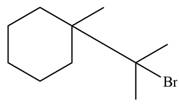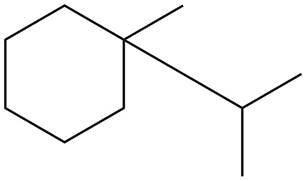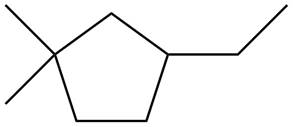
Concept explainers
(a)
Interpretation: The major product formed when given cycloalkane is heated with
Concept introduction: Free radicals are classified as
Halogens react with
Answer to Problem 15.10P
The major product formed when given cycloalkane is heated with

Explanation of Solution
The given species is,

Figure 1
Three types of radicals can be formed from cleavage of
The number of alkyl substituents increases, the stability of radical increases. The order of stability is

Figure 2
The major product formed when given cycloalkane is heated with
(b)
Interpretation: The major product formed when given cycloalkane is heated with
Concept introduction: Free radicals are classified as
Halogens react with alkanes in presence of heat or light to form alkyl halides. This is known as halogenation reaction. This is a free radical substitution reaction. In this the halogen substitutes the hydrogen atom from
Answer to Problem 15.10P
The major product formed when given cycloalkane is heated with

Explanation of Solution
The given species is,

Figure 3
Three types of radicals can be formed from cleavage of
The number of alkyl substituents increases, the stability of radical increases. The order of stability is

Figure 4
The major product formed when given cycloalkane is heated with
(c)
Interpretation: The major product formed when given cycloalkane is heated with
Concept introduction: Free radicals are classified as
Halogens react with alkanes in presence of heat or light to form alkyl halides. This is known as halogenation reaction. This is a free radical substitution reaction. In this the halogen substitutes the hydrogen atom from
Answer to Problem 15.10P
The major product formed when given cycloalkane is heated with

Explanation of Solution
The given species is,

Figure 5
Three types of radicals can be formed from cleavage of
The number of alkyl substituents increases, the stability of radical increases. The order of stability is

Figure 6
The major product formed when given cycloalkane is heated with
(c)
Interpretation: The major product formed when given cycloalkane is heated with
Concept introduction: Free radicals are classified as
Halogens react with alkanes in presence of heat or light to form alkyl halides. This is known as halogenation reaction. This is a free radical substitution reaction. In this the halogen substitutes the hydrogen atom from
Answer to Problem 15.10P
The major product formed when given cycloalkane is heated with

Explanation of Solution
The given species is,

Figure 7
Two types of radicals can be formed from cleavage of
The number of alkyl substituents increases, the stability of radical increases. The order of stability is

Figure 8
The major product formed when given cycloalkane is heated with
Want to see more full solutions like this?
Chapter 15 Solutions
Organic Chemistry
- 8:17 PM Sun Mar 30 Draw the major product of this reaction. Ignore inorganic byproducts. HSCH2CH2CH2SH, BF3 Probler Drawing Ato Bonds Clarrow_forwardpresented by Mr L How the coprion. (Il Done in no wraction, dew the starting redential) доarrow_forward8:16 PM Sun Mar 30 K Draw the major product of this reaction. Ignore inorganic byproducts. Proble 1. CH3MgBr 2. H3O+ F Drawingarrow_forward
- о но оarrow_forwardName the major organic product of the following action of 4-chloro-4-methyl-1-pentanol in neutral pollution 10+ Now the product. The product has a molecular formula f b. In a singly hain, the starting, material again converts into a secule with the molecular kormula CIO. but with comply Draw the major organic structure inhalationarrow_forwardMacmillan Learning Alcohols can be oxidized by chromic acid derivatives. One such reagent is pyridinium chlorochromate, (C,H,NH*)(CICTO3), commonly known as PCC. Draw the proposed (neutral) intermediate and the organic product in the oxidation of 1-butanol by PCC when carried out in an anhydrous solvent such as CH₂C₁₂. PCC Intermediate OH CH2Cl2 Draw the intermediate. Select Draw Templates More с H Cr о Product Draw the product. Erase Select Draw Templates More H о Erasearrow_forward
- If I have 1-bromopropene, to obtain compound A, I have to add NaOH and another compound. Indicate which compound that would be. A C6H5 CH3arrow_forwardProvide the reagents for the following reactions.arrow_forwardIf I have 1-bromopropene, to obtain compound Z, I have to add two compounds A1 and A2. Indicate which compounds are needed. P(C6H5)3arrow_forward
- Draw the major product of this reaction. Ignore inorganic byproducts. Assume that the water side product is continuously removed to drive the reaction toward products. O CH3CH2NH2, TSOH Select to Draw >arrow_forwardPredict the major organic product(s) for the following reaction.arrow_forwardPredict the major organic product(s) for the following reactions.arrow_forward
 Organic Chemistry: A Guided InquiryChemistryISBN:9780618974122Author:Andrei StraumanisPublisher:Cengage Learning
Organic Chemistry: A Guided InquiryChemistryISBN:9780618974122Author:Andrei StraumanisPublisher:Cengage Learning
